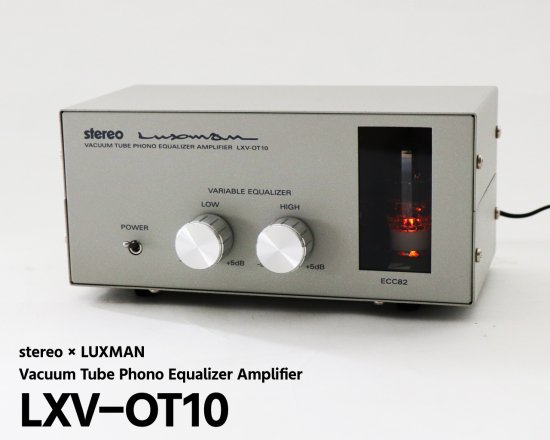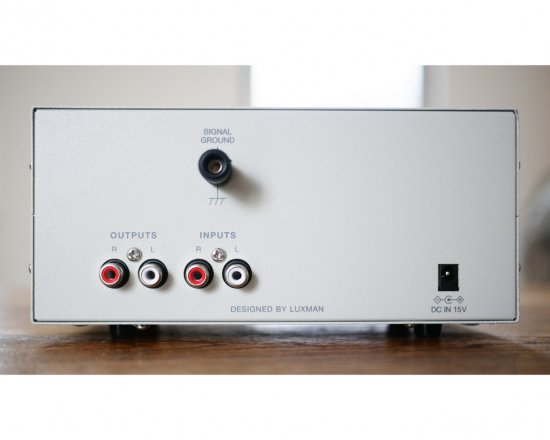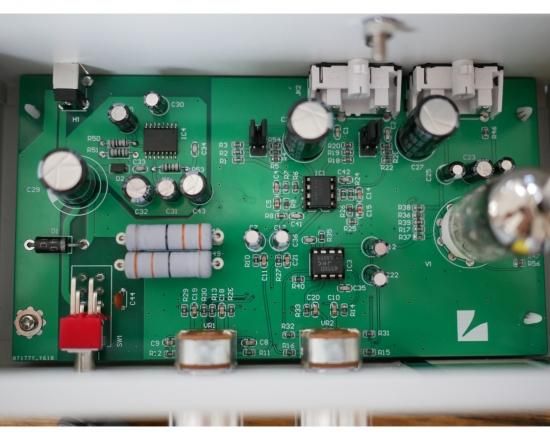Luxman LXV-OT10 Phono Equalizer Amplifier Review/Measurements


Let's take an audio company with nearly 100 years of history. That's Luxman, which has been around since 1925.
Now take one of the oldest audiophile magazines in Japan. That's stereo, which was first published in 1963 -- just one year after the first issue of Stereophile.
Last, take ONTOMO MOOK. I'm not really sure what it is. It seems to be a hobbyist magazine focused on the culture of music ranging from entire issues dedicated to music in figure skating to magazines on building speakers and part of a media conglomerate...
Now, imagine that all three of them, just for fun, decide to create a hobbyist phono kit that you "assemble" yourself with a circuit designed by Luxman and distributed by the magazine, with priority given to subscribers of the magazine. That's what the LXV-OT10 is.

Launched at 18,000 yen in 2020 ($120 USD at 2023 exchange rates), the LXV-OT10 quickly sold out. It sells for about $250+ on eBay (including shipping). It's part of a series of desktop hobbyist kits including amplifiers, FM tuners, and 4 band graphic equalizers, etc.




Some of these products use multi-voltage DC adapters while others require 100V AC power.
Today we're looking specifically the phono eq/amp
Specifications
RATED OUTPUT (GAIN) 250mV (MM: 34dB / MC: 52dB)
INPUT SENSITIVITY MM: 5mV / MC: 0.62mV
INPUT IMPEDANCE MM: 47kΩ / MC: 100Ω
RIAA DEVIATION 20Hz – 20kHz ±0.5dB
THD 0.15% (1kHz, rated output)
S/N 75dB (input shorted, A-weighted)
JJ ECC82 tube (Slovakia)
What is unique is that it has two EQ knobs for manipulated the RIAA correction curve. The center position has a detent, but you can adjust the curves to replicate other curves to your liking. Stereo magazine provides this printable template.

Assembly:
All of the instructions are in Japanese. It took me about 45 minutes to build, of which 15 minutes was spent looking for a good Philips screwdriver. The chassis screws are self-tapping screws that cut into the sheet metal and a PH2 screwdriver despite it seeming like it would be too large, worked the best for me. Like building a PC, there is no soldering involved. It's just a matter of screwing things together and the op amps are already installed. What is very nice is the fit/finish of everything. The rubber feet are simple 3M rubber self-adhesive feet, but the depressions in the metal are so precisely matched to the laser cut feet that it was a joy to put them on. The silkscreen printing is nice and crisp and it really does have the gray color of a Luxman product. Even the PCB has the Luxman logo silkscreened (which is visible from the tube window). The logo for stereo magazine and Luxman are different from the logo used for everythig else, but the typography is great with thoughtful use of kerning, weight, and size.

There are two op amps which are socketed, allowing for simple rolling. They ship with the TI 072 and JRC 4558.
Test Setup:
It's really hard to deal with ground loops when testing phono pre-amps. What worked for me is to ground my Marantz SA-10 to the E1DA Cosmos ADC with a E1DA Scaler at 0 dB as a buffer to address the low input impedance of the default Cosmos ADC. I used a Six Acoustics Inverted RIAA Circuit ver 1.5 with a rated RIAA accuracy: +/- 0.05dB (20Hz - 20KHz). The Luxman grounding lug was grounded to the PCB of this device. These measurements were taken with a NOS JAN 5814A Philips ECG tube.

Self-Noise
Input shorted, the noise was in the single digit µV for MM and double digits µV for MC.


56.5 dB
SINAD
Moving Magnet (5 mV input)

54.6 dB
SINAD
Moving Coil (0.5 mV input)

The tube adds a lot of distortion although noise was well controlled as was the AC mains noise.
RIAA Accuracy in MM vs. MC


I'm not sure what to make of the phase, but at least for the frequency response, assuming that the Six Acoustics Reverse RIAA is truly 0.05 dB accurate, the MM mode was +/- 0.25 dB give or take. That's great! I did slightly boost the treble to get the closest RIAA match. In moving coil mode, I may not have the proper "loading" but it was +/- 1 dB. I really don't know if that's a function of the capacitance, etc. Tuning the EQ could improve this.
REW sweeps show that one of the reasons why vinyl LPs sound good is that electrically, these results would be impressive if they were graded as a speaker.


Overload
The tubes have so much distortion that it's hard to know what is acceptable. If you go with a Western Electric 91E which is supposed to have a pleasant tube sound, they rate at 10% THD+N which is 20 dB SINAD. With that perspective, MM overload is still a low 60 mV or so. On the MC side, however, the performance is a bit better thanks to the low gain and you're approaching 11 mV.


Subjective
While it's nice to nitpick about the phono pre-amp, once you actually start playing vinyl LPs the cartridge is going to add a lot more distortion and the surface noise jumps up. In general, I was happy with the MM mode and the simple EQ allows you to address any cartridge variability. In moving coil mode, when paired with my super-low output MC (Monster Cables Sigma 2000 MC; 0.2 mV) the baseline noise was too loud once I raised the volume to an acceptable level. This was with a 80's era Linn LP12 with a Vahalla power supply. The Luxman manual actually warns against using MC cartridges rated for 0.2 mV output due to noise. On the other hand, the built-in MC phono in my Marantz PM-10 was better. I didn't find the pops/clicks to be unusually bad or different.
My first impressions, subject to sighted bias:
"There's something about the sound that makes you feel like the record player is tracking better. You have a really rich sound stage, very low noise, minimal static/pops. There's a smoothness that feels like subdued treble at first, but if you turn up the dial for the high frequency boost, you just get more treble but you don't lose this sense of smoothness."
The unit was mildly warm to the touch when used with the enclosure. With the top off, using a FLIR thermal camera showed that the large resistors also heat up quite a bit!



Switching the jumpers from MM to MC was a bit of a pain since you have to remove the cover and the capacitors get in the way. I would have preferred a toggle switch on the back.
Conclusions
Vinyl isn't intended for the most detailed, accurate or transparent sound. It's for the fun and for the experience. Why wouldn't you want to listen with your eyes?
Along these lines, I think what is more interesting is the idea of a luxury audio brand collaborating with magazine to create a functional hobbyist-level product. Luxman has an all-tube $6700 phono eq/amp (EQ-500) which is RIAA only and $2400 solid-state phono eq/amp (E-250) which is also RIAA only. This is the only hybrid phono eq/amp Luxman name and the only phono eq/amp from Luxman with non-RIAA curves! Luxman didn't hold back features. You actually get stuff in this kit that isn't found on the full product line. Luxman designed to a price point and focused on looks as much as they did performance. You don't simply get a sloppy brand sticker stuck on an OEM product and we actually got something that is new. Costs are cut by just having one loading option for MM and MC, but the variable EQ is a meaningful addition.
Why don't we have something like this in the US? Can you imagine a Stereophile x McIntosh hobbyist line of kit products? Nelson Pass has DIY options, but they don't look like Pass Labs products, and the kits are designed for electronics hobbyists interested in soldering as opposed to audiophiles looking for IKEA level assembly.
Products like this will help the next generation of audiophile hobbyists develop interest in the gear.
As a marketing exercise that is responsible and thoughtful for its future customers, Luxman deserves a golfing panther.


Let's take an audio company with nearly 100 years of history. That's Luxman, which has been around since 1925.
Now take one of the oldest audiophile magazines in Japan. That's stereo, which was first published in 1963 -- just one year after the first issue of Stereophile.
Last, take ONTOMO MOOK. I'm not really sure what it is. It seems to be a hobbyist magazine focused on the culture of music ranging from entire issues dedicated to music in figure skating to magazines on building speakers and part of a media conglomerate...
Now, imagine that all three of them, just for fun, decide to create a hobbyist phono kit that you "assemble" yourself with a circuit designed by Luxman and distributed by the magazine, with priority given to subscribers of the magazine. That's what the LXV-OT10 is.
Launched at 18,000 yen in 2020 ($120 USD at 2023 exchange rates), the LXV-OT10 quickly sold out. It sells for about $250+ on eBay (including shipping). It's part of a series of desktop hobbyist kits including amplifiers, FM tuners, and 4 band graphic equalizers, etc.
Some of these products use multi-voltage DC adapters while others require 100V AC power.
Today we're looking specifically the phono eq/amp
Specifications
RATED OUTPUT (GAIN) 250mV (MM: 34dB / MC: 52dB)
INPUT SENSITIVITY MM: 5mV / MC: 0.62mV
INPUT IMPEDANCE MM: 47kΩ / MC: 100Ω
RIAA DEVIATION 20Hz – 20kHz ±0.5dB
THD 0.15% (1kHz, rated output)
S/N 75dB (input shorted, A-weighted)
JJ ECC82 tube (Slovakia)
What is unique is that it has two EQ knobs for manipulated the RIAA correction curve. The center position has a detent, but you can adjust the curves to replicate other curves to your liking. Stereo magazine provides this printable template.

Assembly:
All of the instructions are in Japanese. It took me about 45 minutes to build, of which 15 minutes was spent looking for a good Philips screwdriver. The chassis screws are self-tapping screws that cut into the sheet metal and a PH2 screwdriver despite it seeming like it would be too large, worked the best for me. Like building a PC, there is no soldering involved. It's just a matter of screwing things together and the op amps are already installed. What is very nice is the fit/finish of everything. The rubber feet are simple 3M rubber self-adhesive feet, but the depressions in the metal are so precisely matched to the laser cut feet that it was a joy to put them on. The silkscreen printing is nice and crisp and it really does have the gray color of a Luxman product. Even the PCB has the Luxman logo silkscreened (which is visible from the tube window). The logo for stereo magazine and Luxman are different from the logo used for everythig else, but the typography is great with thoughtful use of kerning, weight, and size.

There are two op amps which are socketed, allowing for simple rolling. They ship with the TI 072 and JRC 4558.
Test Setup:
It's really hard to deal with ground loops when testing phono pre-amps. What worked for me is to ground my Marantz SA-10 to the E1DA Cosmos ADC with a E1DA Scaler at 0 dB as a buffer to address the low input impedance of the default Cosmos ADC. I used a Six Acoustics Inverted RIAA Circuit ver 1.5 with a rated RIAA accuracy: +/- 0.05dB (20Hz - 20KHz). The Luxman grounding lug was grounded to the PCB of this device. These measurements were taken with a NOS JAN 5814A Philips ECG tube.

Self-Noise
Input shorted, the noise was in the single digit µV for MM and double digits µV for MC.
56.5 dB
SINAD
Moving Magnet (5 mV input)
54.6 dB
SINAD
Moving Coil (0.5 mV input)
The tube adds a lot of distortion although noise was well controlled as was the AC mains noise.
RIAA Accuracy in MM vs. MC
I'm not sure what to make of the phase, but at least for the frequency response, assuming that the Six Acoustics Reverse RIAA is truly 0.05 dB accurate, the MM mode was +/- 0.25 dB give or take. That's great! I did slightly boost the treble to get the closest RIAA match. In moving coil mode, I may not have the proper "loading" but it was +/- 1 dB. I really don't know if that's a function of the capacitance, etc. Tuning the EQ could improve this.
REW sweeps show that one of the reasons why vinyl LPs sound good is that electrically, these results would be impressive if they were graded as a speaker.
Overload
The tubes have so much distortion that it's hard to know what is acceptable. If you go with a Western Electric 91E which is supposed to have a pleasant tube sound, they rate at 10% THD+N which is 20 dB SINAD. With that perspective, MM overload is still a low 60 mV or so. On the MC side, however, the performance is a bit better thanks to the low gain and you're approaching 11 mV.
Subjective
While it's nice to nitpick about the phono pre-amp, once you actually start playing vinyl LPs the cartridge is going to add a lot more distortion and the surface noise jumps up. In general, I was happy with the MM mode and the simple EQ allows you to address any cartridge variability. In moving coil mode, when paired with my super-low output MC (Monster Cables Sigma 2000 MC; 0.2 mV) the baseline noise was too loud once I raised the volume to an acceptable level. This was with a 80's era Linn LP12 with a Vahalla power supply. The Luxman manual actually warns against using MC cartridges rated for 0.2 mV output due to noise. On the other hand, the built-in MC phono in my Marantz PM-10 was better. I didn't find the pops/clicks to be unusually bad or different.
My first impressions, subject to sighted bias:
"There's something about the sound that makes you feel like the record player is tracking better. You have a really rich sound stage, very low noise, minimal static/pops. There's a smoothness that feels like subdued treble at first, but if you turn up the dial for the high frequency boost, you just get more treble but you don't lose this sense of smoothness."
The unit was mildly warm to the touch when used with the enclosure. With the top off, using a FLIR thermal camera showed that the large resistors also heat up quite a bit!
Switching the jumpers from MM to MC was a bit of a pain since you have to remove the cover and the capacitors get in the way. I would have preferred a toggle switch on the back.
Conclusions
Vinyl isn't intended for the most detailed, accurate or transparent sound. It's for the fun and for the experience. Why wouldn't you want to listen with your eyes?
Along these lines, I think what is more interesting is the idea of a luxury audio brand collaborating with magazine to create a functional hobbyist-level product. Luxman has an all-tube $6700 phono eq/amp (EQ-500) which is RIAA only and $2400 solid-state phono eq/amp (E-250) which is also RIAA only. This is the only hybrid phono eq/amp Luxman name and the only phono eq/amp from Luxman with non-RIAA curves! Luxman didn't hold back features. You actually get stuff in this kit that isn't found on the full product line. Luxman designed to a price point and focused on looks as much as they did performance. You don't simply get a sloppy brand sticker stuck on an OEM product and we actually got something that is new. Costs are cut by just having one loading option for MM and MC, but the variable EQ is a meaningful addition.
Why don't we have something like this in the US? Can you imagine a Stereophile x McIntosh hobbyist line of kit products? Nelson Pass has DIY options, but they don't look like Pass Labs products, and the kits are designed for electronics hobbyists interested in soldering as opposed to audiophiles looking for IKEA level assembly.
Products like this will help the next generation of audiophile hobbyists develop interest in the gear.
As a marketing exercise that is responsible and thoughtful for its future customers, Luxman deserves a golfing panther.
Last edited:


